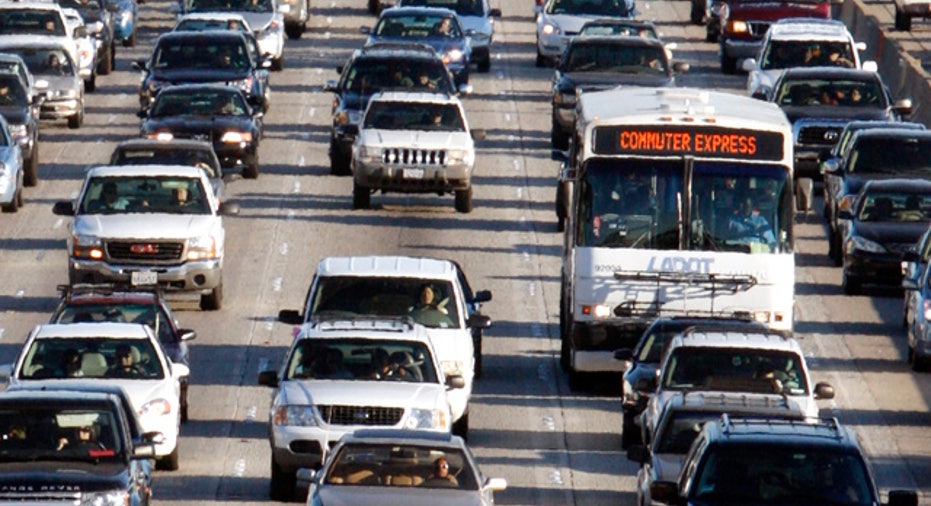How Gridlock Saves Lives

Traffic stinks. It stinks so much, in fact, that researchers invest countless hours in an effort to calculate exactly how many hours and how much money traffic costs us every year:
- The latest Texas Transportation Institute analysis put the number of hours spent stuck in traffic at 4.8 billion in 2011, an average of 34 hours per urban commuter. Figuring for gas and lost wages (everybody would rather be at the office) that's a $101 billion cost.
- A California economist, analyzing 85 metropolitan areas between 1990 and 2003, added slow job growth to the list of ills, positing that if traffic jams were cut in half, employment would rise 10% to 30% in congested cities, such as Los Angeles.
- Those idling hours burn up to 2.5 billion gallons of extra fuel, contributing to smog. When the Harvard School of Public Health ran the math last year and isolated emissions from idling, it concluded that traffic led to more than 2,200 premature deaths in the nation's 83 largest cities.
And now for the good news: Traffic is saving lives.
You will live to gripe about it
As is often the case, all this research may be overlooking the positive. The traffic that we love to hate does do at least one very good thing: It slows us down. And if you want to reach your destination alive -- maybe late, maybe enraged, maybe anxious, but alive -- that's a good thing, indeed. "Speed-related crashes are one of the biggest problems in highway safety," says Russ Rader, spokesperson for the Insurance Institute for Highway Safety. He says one-third of all fatal crashes in the U.S. (some 1,000 per month) are due to speeding. "Research clearly shows that when speeds go up, deaths go up, and when speed goes down, deaths go down." The link gets even more direct:
- Analyzing cities worldwide, two Swedish researchers noticed that where congestion was high (Delhi, India; New York), vehicular death rates were notably lower than in less-congested cities (Mumbai, India; Houston). Writing in the book "Urban Transport Development: A Complex Issue," the professors found speed contributed to both the probability of a crash occurring and the severity of the injuries.
- In the United States, a 2007 survey by the Reason Foundation, a libertarian think tank, observed that the two deadliest states for car accidents -- Montana (2.25 deaths per 100 million vehicle miles) and South Dakota (2.21) -- were also two of the four states (along with North Dakota and Wyoming) that enjoyed no congestion. "Most of the states with very low accident rates also have very high congestion," the study's lead author, David Hartgen, said at the time.
- Even when speeds on a rural and urban section of the same highway were capped at 55 mph in the mid-1970s, the fatality rates were 89% higher on the rural portions of the same highway, "illustrating the safety benefits produced by traffic congestion," writes Leonard Evans in his book "Traffic Safety."
In an interview, Evans, a retired General Motors physicist, says studies worldwide mirror those results. "The evidence is overwhelmingly compelling that the more congested the region is, the lower will be the fatality rates," he says. Seeking safe highways? Try Washington, D.C., which routinely ranks as the most congested place in the country. Want to escape all the traffic? Head to Montana. But you'll have a greater chance of being killed on the road there than anywhere else. "Increasing your travel speed by a couple miles per hour doubles your risk of death," says Evans. "There's no case for congestion. Congestion's something undesirable. But one of the benefits, if you could say it, is that if you have congestion the fatality risk declines." And that's not all. Proponents of so-called slower cities have found further reason to praise the cursed traffic jam: Because it slows traffic, it ultimately creates a safer and more robust environment for pedestrians and cyclists, a phenomenon the proponents are beginning to note in some cities. (See "How not to get hit by a car.") Insurance rates continue to go with the flow
Don't expect that a crowded city's slower pace of traffic will be reflected in a lower car insurance bill. Auto insurance premiums remain higher in cities than in rural areas, thanks to the cumulative cost of lots of small accidents and generally higher theft and vandalism rates. (See "How your ZIP code drives up your car insurance.") "Anyplace where you've got more people together, you've got a greater chance of those things happening," says Bob Passmore, senior director of personal lines for the Property Casualty Insurers Association of America. "There's going to be higher insurance rates in more congested areas, just because of the sheer number of cars." Even Progressive's Snapshot program, which offers discounts based on driving behavior, doesn't monitor whether you're exceeding the speed limit. It monitors hard braking, an indicator of risky driving, and other factors. (See "'Snapshot' insurance: What's the catch?")
The original article can be found at CarInsurance.com:How gridlock saves lives